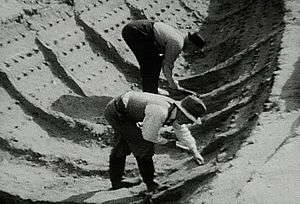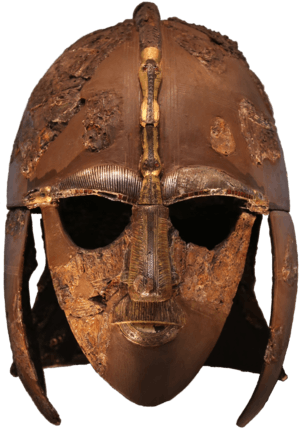Charles Phillips (archaeologist)
Charles William Phillips OBE (24 April 1901 – 23 September 1985) was a British archaeologist best known for leading the 1939 excavation of the Sutton Hoo burial ship, an intact collection of Anglo-Saxon grave-goods, possibly that of the 7th-century East Anglian king Raedwald.[1] He was awarded the Victoria Medal of the Royal Geographical Society in 1967 for his contributions to the topography and mapping of Early Britain.
Charles Phillips | |
|---|---|
| Born | Charles William Phillips 24 April 1901 England |
| Died | 23 September 1985 (aged 84) |
| Nationality | British |
| Known for | Leader of the Sutton Hoo ship-burial excavation, 1939 |
| Spouse(s) | Margaret Mann Phillips |
| Awards | Victoria Medal, 1967 |
| Scientific career | |
| Fields | Archaeology |
Early life and education
Charles Phillips was born on 24 April 1901,[2] the son of Harold and Mary Elizabeth.[3] His parents had met in London and were married on 14 October 1899.[3] Harold Phillips had started to suffer from depression around 1893, and despite a number of "crises" during the short engagement, as Charles Phillips would later describe them, apparently no efforts were made to apprise his fiancée's family of his condition; nevertheless, none of her relatives showed up for the wedding.[3] The couple had two sons and a daughter, with Charles being the youngest.[4] Despite attempts at therapy, Harold Phillips killed himself on 30 January 1907.[4]
For about a year Charles Phillips was sent to live with his mother's parents in Ardington, after which he moved back in with his mother in Henley-on-Thames.[5] There he attended Henley Grammar school, which he termed "a rather difficult time at the rather decayed" school; once his mother obtained a diploma in dairying from Reading University and moved to tend to the dairy at Arundel Castle, he lodged with an old friend of his father, visiting his family for the holidays.[4]
From 1909 to 1910 Phillips was educated at Littlehampton Commercial School, his tuition paid for by the Freemasons of which his father had been a member, and by their graces he was installed in the Royal Masonic School for Boys in Bushey, Hertfordshire, in January 1911.[6] Phillips was the only new boy assigned to his junior house.[7] He characterised the headmaster of the other as a "sadist" who was forced out two years later due to a "scandal."[7] His own time at the school lasted until 1919.[8] This included a stint at Stonehenge at the end of World War I, when a shortage of workers necessitated the use of older schoolboys to take in the harvest nearby.[9] His time digging potatoes was short, for twenty-eight of the thirty schoolboys came down with diarrhoea.[9] Phillips was not afflicted, and together with the other well schoolboy and an Army cook, spent days digging latrines.[9] While home for Christmas holidays that year Phillips spent time exploring Burgh Castle, collecting pieces of Romano-British pottery that were placed in the school library.[10] On leaving school the following term, Selwyn College, Cambridge granted him an exhibition in history.[8]
Sutton Hoo


Phillips was in charge of the excavation of the Sutton Hoo ship-burial, widely considered the grave of the Anglo-Saxon king Rædwald of East Anglia, from 10 July to 25 August 1939.[11][12] Excavation of a large burial mound had begun in early May under the leadership of Basil Brown, who the previous year had opened several smaller mounds nearby.[13] On 11 May, the remainder of an iron ship rivet was found, and seven days later Guy Maynard, the then curator of Ipswich Museum, was informed of the "indications of a large vessel" remaining in the soil.[14] Phillips, then a fellow at Selwyn College and working on excavations at Little Woodbury, was alerted to the discovery by Maynard; visiting the site on 6 June, Phillips said "it could be the ship of a King".[15] Due to his experience with excavations the Sutton Hoo ship-burial was put under his command.[14] With the ship cleared but for the burial chamber, he arrived at Sutton Hoo on 8 July, and began work two days later.[16]
Awards and honors
He was awarded the Victoria Medal of the Royal Geographical Society in 1967 for his contributions to the topography and mapping of Early Britain.[17]
Personal life
He was married to Margaret Mann Phillips, the Erasmus scholar.[1][18]
Publications
- Phillips, Charles W. (April 1940). "The Excavation of the Sutton Hoo Ship-burial". The Antiquaries Journal. Society of Antiquaries of London. XX (2): 149–202. doi:10.1017/S0003581500009677.
- Phillips, Charles W. (October 1940). "The Sutton Hoo Burial Ship". The Mariner's Mirror. Society for Nautical Research. XXVI (4): 345–355. doi:10.1080/00253359.1940.10657405.CS1 maint: ref=harv (link)

- Phillips, Charles W. (February 1941). "Ancestor of the British Navy". National Geographic. The National Geographic Society. LXXIX (2): 247–268.CS1 maint: ref=harv (link)
- Phillips, Charles W. (October 1946). "The World from Sutton Hoo". The Geographical Magazine. Royal Geographical Society. XIX (6): 235–343.CS1 maint: ref=harv (link)
- Phillips, Charles W. (1956). "The Excavation of the Sutton Hoo Ship-Burial". In Bruce-Mitford, Rupert (ed.). Recent Archaeological Excavations in Britain: Selected Excavations 1939–1955 with a Chapter on Recent Air-Reconnaissance. New York: Macmillan. pp. 145–166.CS1 maint: ref=harv (link)
- Phillips, Charles W. (1970). "Forward". In Grohskopf, Bernice (ed.). The Treasure of Sutton Hoo. New York: Atheneum. pp. xi–xiv.CS1 maint: ref=harv (link)
- Phillips, Charles W. (1987). My Life in Archaeology. Gloucester: Alan Sutton. ISBN 0-86299-362-8.CS1 maint: ref=harv (link)
References
- Phillips 1987.
- Geographical Journal 1986, p. 146.
- Phillips 1987, pp. 2–3.
- Phillips 1987, p. 3.
- Phillips 1987, pp. 1–3.
- Phillips 1987, pp. 3–4.
- Phillips 1987, p. 4.
- Phillips 1987, pp. 5–7.
- Phillips 1987, p. 5.
- Phillips 1987, pp. 5–6.
- Markham 2002, p. 27.
- Bruce-Mitford 1975, p. 732.
- Markham 2002, p. 15.
- Markham 2002, p. 16.
- Markham 2002, pp. 16–17.
- Markham 2002, pp. 22–27.
- Geographical Journal 1986.
- H. 1988.
Bibliography
- Bruce-Mitford, Rupert (1975). The Sutton Hoo Ship-Burial, Volume 1: Excavations, Background, the Ship, Dating and Inventory. London: British Museum Publications. ISBN 0-7141-1334-4.CS1 maint: ref=harv (link)
- "C. W. Phillips, OBE, MA, FSA, 1901-1985". Obituaries. The Geographical Journal. The Royal Geographical Society. 152 (1): 146–147. March 1986. JSTOR 633003.
- H., M. J. (July 1988). "Margaret Mann Phillips (1906–1987)". Obituaries. French Studies. The Society for French Studies. XLII (3): 377–378. doi:10.1093/fs/XLII.3.377.CS1 maint: ref=harv (link)
- Markham, Robert A. D. (2002). Sutton Hoo: through the rear view mirrow, 1937–1942. Woodbridge: Sutton Hoo Society. ISBN 9780954345303.CS1 maint: ref=harv (link)